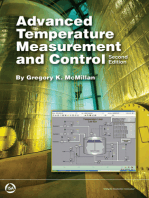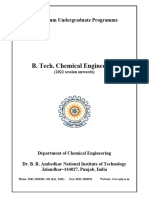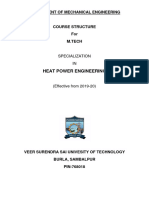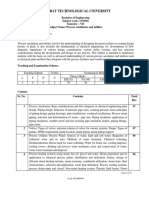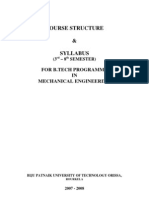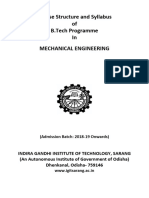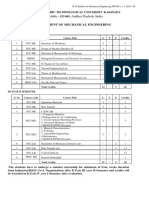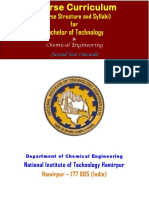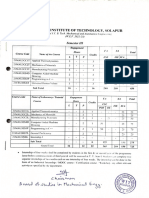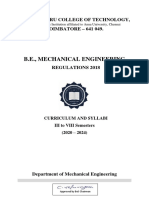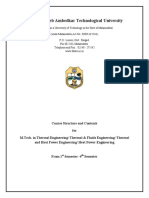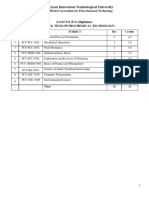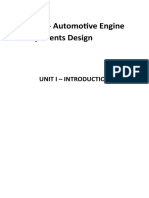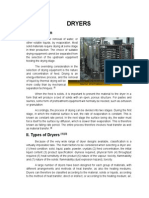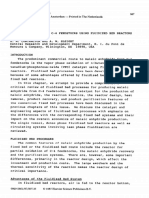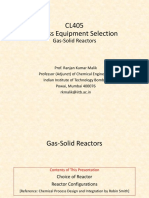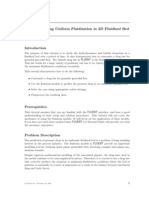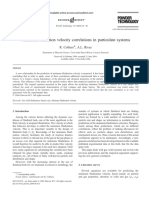R2018 Chem II Sem Syllabus
R2018 Chem II Sem Syllabus
Uploaded by
SathistrnpcCopyright:
Available Formats
R2018 Chem II Sem Syllabus
R2018 Chem II Sem Syllabus
Uploaded by
SathistrnpcCopyright
Available Formats
Share this document
Did you find this document useful?
Is this content inappropriate?
Copyright:
Available Formats
R2018 Chem II Sem Syllabus
R2018 Chem II Sem Syllabus
Uploaded by
SathistrnpcCopyright:
Available Formats
KONGU ENGINEERING COLLEGE, PERUNDURAI, ERODE – 638 060
(Autonomous)
M.Tech. DEGREE IN CHEMICAL ENGINEERING
CURRICULUM
(For the candidates admitted from academic year 2018-19 onwards)
SEMESTER – II
Hours / Maximum
Course Week Marks
Course Title Credit CBS
Code
L T P CA ESE Total
Theory/Theory with Practical
18MHT21 Chemical Equipment Design 3 1 0 4 50 50 100 PC
18MHC21 Advanced Mass Transfer Operations 3 0 3 4 50 50 100 PC
18MHT22 Chemical Engineering Thermodynamics 3 0 0 3 50 50 100 PC
Elective – I 3 0 0 3 50 50 100 PE
Elective - II 3 0 0 3 50 50 100 PE
Elective - III 3 0 0 3 50 50 100 PE
Practical
18MHP21 Mini Project 0 0 4 2 100 0 100 PR
Total 22
CA – Continuous Assessment, ESE – End Semester Examination, CBS – Curriculum Breakdown Structure
KEC-R2018-MTech-Chem-Curriculum and Syllabi 1/51
LIST OF PROFESSIONAL ELECTIVES
Course Hours/Week
Course Title Credit CBS
Code L T P
SEMESTER II
18MHE01 Advanced Fluidization Engineering 3 0 0 3 PE
18MHE02 Energy Management in Chemical Industries 3 0 0 3 PE
18MHE03 Project Engineering of Process Plants 3 0 0 3 PE
18MHE04 Advanced Separation Techniques 3 0 0 3 PE
18MHE05 Computational Fluid Dynamics 3 0 0 3 PE
18MHE06 Mixing Technology 3 0 0 3 PE
18MHE07 Process Instrumentation and Automation 3 0 0 3 PE
18MHE08 Process Intensification 3 0 0 3 PE
18MHE09 Risk Analysis 3 0 0 3 PE
SEMESTER III
18MHE10 Chemical Product Design 3 0 0 3 PE
18MHE11 Process Optimization Techniques 3 0 0 3 PE
18MHE12 Bio-Process Engineering 3 0 0 3 PE
18MHE13 Multiphase Flow 3 0 0 3 PE
Piping Flow sheeting Process and Instrumentation
18MHE14 3 0 0 3 PE
Diagrams
18MHE15 Industrial Wastewater Treatment 3 0 0 3 PE
18MHE16 Advanced Materials for Chemical Engineers 3 0 0 3 PE
18MHE17 Industrial Drying 3 0 0 3 PE
18MHE18 Design and Analysis of Experiments 3 0 0 3 PE
KEC-R2018-MTech-Chem-Curriculum and Syllabi 2/51
18MHT21 CHEMICAL EQUIPMENT DESIGN
L T P Credit
3 1 0 4
Preamble This course provides a basic understanding of design parameter, complete knowledge of
design procedures for commonly used process equipment like pressure vessel, heat
exchangers, distillation column, absorption column, extractor, crystallizer, cooling tower and
dryers. The concepts and skills learnt in process calculations, thermodynamics, momentum
transfer, mass transfer and heat transfer will be utilized.
Pre-requisites Nil
UNIT – I 9
Design of Pressure Vessel: Introduction- pressure vessel codes and standards- Fundamental principles and
equations, Failure mode in pressure vessel. Design of pressure vessels under combined loading and high
pressure. Design of storage vessel.
UNIT – II 9
Design of Heat Transfer Equipment: Process design of Shell and tube heat exchanger, double pipe heat
exchanger – estimation of individual and overall heat transfer coefficient, estimation of pressure drop. Design
of single effect evaporator – calculation of steam requirement and heat transfer area.
UNIT – III 9
Design of Mass Transfer Equipment: Design of distillation column- Determination of number of stages,
column diameter and height – McCabe Thiele and Ponchon Savarit method. Design of absorption column –
Calculation of diameter and height, Absorption factor – estimation of number of plates required.
UNIT – IV 9
Design of Extractor and Crystallizer: Extractor - Industrial applications of liquid-liquid extraction, choice
of solvent, equipment used for liquid-liquid extraction, process design of counter current multistage extractor
– steps involved in determination of number of stages. Design of crystallizers – Determination of length and
number of sections.
UNIT – V 9
Design of Miscellaneous Equipment: Design of cooling tower - Calculation of HTU, NTU, Height and
diameter. Design of Reboiler – Typical design procedure for thermosyphon reboiler and estimation of various
parameters. Design of dryers – Design of rotary dryer – Estimation of length and diameter, Design of fluid
bed dryer – calculation of diameter of distributor grid and disengagement zone.
Lecture:45, Tutorial:15, Total:60
REFERENCE BOOKS:
1. Sinnott Ray and Towler Gavin, “Coulson and Richardson‟s Chemical Engineering Series Chemical
Engineering Design”, 5th Edition, Volume 6, 2013.
2. Kern D.Q., “Process Heat Transfer”, International Student Edition, McGraw Hill, 2002.
3. Mahajani V.V. and Umarji S.B., Joshi‟s “Process Equipment Design”, 4th Edition, Macmillan Publishers
India Ltd., New Delhi, 2010.
KEC-R2018-MTech-Chem-Curriculum and Syllabi 3/51
18MHC21 ADVANCED MASS TRANSFER OPERATIONS
L T P Credit
3 0 3 4
Preamble This course provides an understanding of the multicomponent separation in Conventional
distillation columns, Complex columns and system of columns and provides an exposure to
multicomponent separation analysis.
Prerequisites Nil
UNIT – I 9
Thermodynamic Relationships for Multicomponent Mixtures: Calculation of VLE and enthalpies of
multicomponent mixtures, Equation of state and its usage in prediction of K values and Enthalpies, Use of
multiple equation of state.
UNIT – II 9
Introduction to Multicomponent Distillation: Separation of multicomponent mixture by use of one
equilibrium stage, Multi stage separation of binary mixtures, Separation of multicomponent mixtures at total
reflux.
UNIT – III 9
Systems of Azeotropic and Extractive Distillation Column: Qualitative characteristics. Solving problems
involving single column. Systems of columns in the service of separating mixtures of non ideal solutions.
UNIT – IV 9
Liquid-liquid Extraction: Stage wise calculations for multi component with multiple feed streams using
reflux and mixed solvents. Liquid-liquid extraction with chemical reaction
UNIT – V 9
Multi Component Gas Absorption: Horton-Franklin method, Edmister method. Mass transfer in gas
absorption with and without chemical reaction, model solutions by Dankwerts, Brian, Perry and Pigford.
List of Experiments:
1. Determination of the activity coefficients and Van Laar constant for the given system by performing
VLE experiments
2. Estimation of Height Equivalent to a Theoretical Plate and find out % recovery of the overhead and
bottom products of given system under total reflux conditions
3. Determination of vaporization efficiency (Ev) and Thermal efficiency (Et) of the given system using
steam distillation apparatus
4. Determination of the diffusivity of the given liquid to air
5. Verifying the Raleigh„s equation for the given system using simple distillation setup
6. Conduction of Simple Leaching studies
7. Conduction of liquid-liquid extraction studies and plot binodal curve for the given ternary system
8. Studying the concept of surface evaporation and finding the constants of Himus Equation
9. Estimation of Mass transfer co-efficient using Wetted wall column
10. Estimation of Mass transfer co-efficient using packed absorption column
Lecture :45, Practical:45, Total: 90
REFERENCE BOOKS:
1. Dutta B.K., “Principles of Mass Transfer and Separation Processes”, Prentice Hall India Learning Pvt.
Ltd., 2009.
2. Treybal Robert E., “Mass Transfer Operations”, 3rd Edition, McGraw-Hill Book Company, 1980.
3. Ross Taylor R. Krishna, “Multicomponent Mass Transfer”, Wiley Series in Chemical Engineering,
John Wiley & Sons, New York, 1993.
4. Holland, Charles Donald, “Fundamentals of Multicomponent Distillation”, McGraw-Hill, New York,
1997.
KEC-R2018-MTech-Chem-Curriculum and Syllabi 4/51
18MHT22 CHEMICAL ENGINEERING THERMODYNAMICS
L T P Credit
3 0 0 3
Preamble This course presents the laws of thermodynamics and their applications in process industries
Prerequisites Nil
UNIT – I 9
Laws of Thermodynamics: Basic concepts; first law of thermodynamics - applications to closed and open
systems; second law of thermodynamics; Carnot theorem; applications of second law to the feasibility
analysis of devices and processes; evaluation of entropy change - mixing and separation of gases, mixing and
separation of liquids, heating and cooling of process fluids.
UNIT – II 9
Properties of Solutions: Molar properties and partial molar properties; methods for determination of partial
molar properties; ideal and non-ideal solutions; Gibbs-Duhem equation; mixing of liquids - volume change,
enthalpy change, Gibbs free energy change.
UNIT – III 9
Phase Equilibrium: Vapour-liquid equilibrium; fugacity and fugacity coefficient; activity and activity
coefficient; Raoult‟s law; modified Raoult‟s law; phase diagram of binary system; models for excess Gibbs
free energy - Margules two-suffix equation, Van Laar equation, Wilson equation; criterion for equilibrium
between phases in multi-component non-reacting system in terms of chemical potential and fugacity;
thermodynamic consistency test of VLE data.
UNIT – IV 9
Chemical Reaction Equilibrium: Thermodynamic analysis of chemical reactions – single reactions,
simultaneous parallel reactions, prediction of equilibrium composition of reaction mixture; homogeneous gas
phase reactions; homogeneous liquid phase reactions; standard Gibbs free energy change and reaction
equilibrium constant; evaluation of standard free energy change; evaluation of equilibrium constant.
UNIT – V 9
Refrigeration and Liquefaction: Refrigeration principles; Carnot refrigeration cycle; methods of
refrigeration – vapour compression refrigeration, absorption refrigeration; evaluation of COP and capacity of
refrigeration cycles; air refrigeration; refrigerants for low temperature refrigeration; ozone depletion potential
of refrigerants; liquefaction of gases; methods for liquefaction of gases – Claude liquefaction process; Linde
liquefaction process.
Total: 45
REFERENCE BOOKS:
1. Smith J.M., Van Ness H.C., Abbott M.M., Swihart M.T., “Introduction to Chemical Engineering
Thermodynamics”, 8th Edition, McGraw-Hill Education, 2017.
2. Kyle B.G., “Chemical and Process Thermodynamics”, 3rd Edition, Pearson Education India, 2015.
3. Tassios D.P., “Applied Chemical Engineering Thermodynamics”, Springer-Verlag, Berlin Heidelberg
GmbH, 2014.
KEC-R2018-MTech-Chem-Curriculum and Syllabi 5/51
18MHL31 TECHNICAL ANALYSIS LABORATORY
L T P Credit
0 0 3 1
Preamble: This course covers a variety of methods of analysis in chemical instrumentation used to
determine experimentally the various properties of the Waste water, Polymers, chemicals
etc.
Pre-requisites: Nil
List of Experiments: *
1. UV Spectro Photometer: Analysis of Iron, Cobalt, etc, in the given sample.
2. Determination of BOD, COD for the given Industrial wastewater.
3. Analysis of water: pH, Conductivity, Hardness, Chlorides and Sulphate.
4. Flame Photometer: Determination of Sodium and Potassium.
5. Nephelometer: Determination of Turbidity.
6. Conductometric Titrations.
7. Potentiometric Titrations
8. Oswald Viscometer: Viscosity Measurement for Polymer solutions.
9. Thermodynamic Parameters for first order Kinetics.
10. Determination of Melting and Boiling points of solid and liquid samples.
11. Atomic Absorption Spectroscopic Analysis of heavy metals in Industrial Wastewater.
12. Infrared (IR) spectroscopic analysis of Organic compounds.
*Any ten experiments can be offered
Total:45
REFERENCE BOOKS:
KEC-R2018-MTech-Chem-Curriculum and Syllabi 6/51
18MHE01 ADVANCED FLUIDIZATION ENGINEERING
L T P Credit
3 0 0 3
Preamble: This course provides an overview about the fluidization phenomena and technology. It gives
vast knowledge about flow regimes, hydrodynamics of bubbling, turbulent, fast fluidized
beds and pneumatic conveying.
Prerequisites: Nil
UNIT – I 9
Applications of Fluidised Beds: Introduction, Industrial application of fluidised beds, physical operations and
reactions
UNIT – II 9
Mapping of Regimes and Dense Bed: Fixed beds of particles, types of fluidization without carryover and with
carryover of particles, mapping of fluidization regimes, distributor types, Davidson model for gas flow at bubbles
UNIT – III 9
Heat and Mass Transfer in Fluidised Bed Systems: Heat and Mass transfer between fluid and solid. Gas
conversion in bubbling beds. Heat transfer between fluidised bed and surfaces.
UNIT – IV 9
Elutriation and Entrainment: RTD and also distribution of solid in a fluidised bed, circulation systems -
circuits for the circulation of solids, flow of gas- solid mixtures in downcomers, flow in pneumatic transport lines.
UNIT – V 9
Design of Fluidised Bed Systems: Three phase fluidisation, design of fluidization columns for physical
operations, catalytic and non- catalytic reactions.
Total: 45
REFERENCE BOOKS:
1. Kunii Diazo and Levenspiel O., “Fluidization Engineering”, 2nd Edition, Butterworth Heinemann, 1991.
2. Davidson J.F. and Harrison, “Fluidisation”, Academic Press, London, 1990.
KEC-R2018-MTech-Chem-Curriculum and Syllabi 7/51
18MHE02 ENERGY MANAGEMENT IN CHEMICAL INDUSTRIES
L T P Credit
3 0 0 3
Preamble: This course gives a broad overview about renewable and non-renewable energy resources,
energy consumption, planning, energy audit and optimization. It also outlines the need for
energy recovery and heat recovery techniques.
Prerequisites: Nil
UNIT – I 9
General: Energy Resources: Coal, Petroleum, Natural gas; Reserves and Depletion, need for conservation
UNIT – II 9
Power Generation: Fossil-fueled power plants: components, advanced cycles; Nuclear-fueled power plants:
nuclear energy, radioactivity, nuclear reactors, nuclear fuel cycle, fusion; Co-Generation of power;
Generation Process: Economical and technical efficiency, Socio economic factor
UNIT – III 9
Alternative Energy: Renewable Sources: Hydropower, wind energy, geothermal energy, tidal power, ocean
wave power, ocean thermal power, solar Energy, biomass energy; Issues and challenges in using the
renewable energy sources
UNIT – IV 9
Energy Consumption and Audit: Various types of Energy audit, Advantages of each type; Bureau of
Energy Efficiency; Energy Conservation act of 2001. Concept of monitoring and targeting, energy targets,
reporting techniques, waste avoidance, prioritizing. Exergy Analysis
UNIT – V 9
Optimisation Techniques in Energy Management: Recovery of waste heat using recuperative and
regenerative heat exchangers; optimum shell and tube exchanger networks, evaporator systems, boiler turbo
generator system.
Total: 45
REFERENCE BOOKS:
1. Twidell John and Weir Tony, “Renewable Energy Sources”, 2nd Edition, Taylor & Francis, New York,
2006.
2. Fay James A. and Golomb Dan S., “Energy and the Environment”, Oxford University Press, Inc., New
York, 2002.
3. Beggs Clive, “Energy: Management Supply and Conservation”, Butterworth-Heinemann, Oxford, 2002.
KEC-R2018-MTech-Chem-Curriculum and Syllabi 8/51
18MHE03 PROJECT ENGINEERING OF PROCESS PLANTS
L T P Credit
3 0 0 3
Preamble: This course introduces the basic concepts of Project Engineering and Management to the
students to enable them to apply these techniques during the construction of chemical process
plants. After undergoing this course, students will be able to develop PERT/CPM networks,
prepare project reports and evaluate the economic viability of projects
Prerequisites: Nil
UNIT – I 9
Project Identification and Process Planning: Project definition, Project Profile and standards, Feedback
information (MIS), Evaluation and Modification, Selection, Criteria. Planning the process, Strategic and
Managerial Planning, Organizing the process planning.
UNIT – II 9
Project Engineering: Economic Balancing, Network Planning, Methods (PERT/CPM), Engineering Flow
Diagrams, Cost requirements, Analysis and Estimation of Process Feasibilities (Technical/Economical)
Analysis, Application of reliability theory.
UNIT – III 9
Engineering Management: Plant Engineering Management, Objectives, Programme, Control, Plant
Location and Site Selection, Layout diagrams, Selection and procurement of equipment and machineries,
Installation, Decommissioning, Commissioning and performance appraisal, Strategies choice and Influence,
Product planning and development, Provision and maintenance of service facilities.
UNIT – IV 9
Financial Aspects: Cost and Costing, Cost Control systems, Cost – Benefit Ratio Analysis, Project
Budgeting, Capital Requirements, capital Market, Cash Flow Analysis, Break even strategies. Defining
project financing, typical project stages, setting up a basic project finance structure, risk management in
context of project financing.
UNIT – V 9
Legal Aspects of Business Enterprises: Government regulations on procurement of raw materials and its
allocation. Export – Import regulations, Pricing policy, Industrial licensing procedure, Excise and other
commercial taxes, Policies on depreciation and corporate tax, Labour laws, Social welfare legal
measurements, Factory act, Regulations of Pollution Control Board.
Total: 45
REFERENCE BOOKS:
1. Peters M.S. and Timmerhaus K.D., “Plant Design and Economics for Chemical Engineers”, McGraw
Hill (ISE), 2002.
2. Clements T. and Gido L., “Effective Project Management”, Thomson Education Press, New Delhi, 2007.
3. Pathi P.K., “Labour and Industrial Laws”, 2nd Edition, Prentice Hall India, 2012.
KEC-R2018-MTech-Chem-Curriculum and Syllabi 9/51
18MHE04 ADVANCED SEPARATION TECHNIQUES
L T P Credit
3 0 0 3
Preamble: This course highlights the recent advancements in separation techniques and provides an
exposure with the selection criteria of membrane materials, adsorbents, etc.
Prerequisites: Nil
UNIT – I 9
Recent Advancements in Separation Techniques: Recent advances in separation techniques based on size,
surface properties, ionic properties and other special characteristics of substances. process concept, theory and
equipment used in cross flow filtration, cross flow electro filtration and dual functional filter. surface based
solid - liquid separations involving a second liquid, sirofloc filter.
UNIT – II 9
Membranes and Modules: Types and choice of membranes; membrane manufacturing techniques; plate and
frame, tubular, spiral wound and hollow fiber membrane reactors and their relative merits.
UNIT – III 9
Membrane Processes: Dialysis, reverse osmosis, nanofiltration, ultrafiltration, and microfiltration and
donnan dialysis; design of the reverse osmosis plant - cleaning of membrane - economics of membrane
operations.
UNIT – IV 9
Adsorption and Ionic Separations: Adsorption based Processes: Types and choice of adsorbents, Affinity
chromatography and immuno chromatography; Ionic Separation Processes: Working principle, controlling
factors, equipment employed for electrophoresis, dielectrophoresis, ion exchange chromatography and electro
dialysis.
UNIT – V 9
Other Techniques: Separations involving lyophilisation, pervaporation and permeation techniques for solids,
liquids and gases; zone melting; adductive crystallization; foam separation; supercritical fluid extraction;
Industrial effluent treatment by modern techniques
Total: 45
REFERENCE BOOKS:
1. Perry Robert H., “Perry‟s Chemical Engineers‟ Hand Book”, 8th Edition, McGraw Hill, New York,
2007.
2. Scott K. and Hughe R., “Industrial Membrane Separation Technology”, Blackie Academic and
Professional Publications, 1996.
3. Humphrey Jimmy L. and Killer George E., “Separation Process Technology”, McGraw-Hill
Publications, New York, 1996.
KEC-R2018-MTech-Chem-Curriculum and Syllabi 10/51
18MHE05 COMPUTATIONAL FLUID DYNAMICS
(Common to Chemical Engineering and Food Technology branches)
L T P Credit
3 0 0 3
Preamble: With the advent of high speed computing, CFD has become an integral part of engineering
design, simulation and performance analysis. This course deals with the fundamentals of
CFD, grid generation, meshing and solution techniques using Finite Volume Method.
Prerequisites: Nil
UNIT – I 9
Conservation Laws of Fluid Motion and Boundary Conditions: Governing equations of fluid flow and
heat transfer, equations of state, Navier-Stokes equations for Newtonian fluid, conservative form of governing
equations of flow, differential and integral forms of general transport equations, classification of physical
behavior.
UNIT – II 9
Finite Volume Method for Diffusion and Convective- Diffusion Problems: Finite volume method for one-
dimensional, two-dimensional and three-dimensional steady state diffusion, steady one-dimensional
convection and diffusion, the central differencing scheme. Properties of discretization schemes, assessment of
the central differencing scheme for convection-diffusion problems, the upwind differencing scheme, the
hybrid differencing scheme, the power-law scheme, higher order differencing schemes for convection-
diffusion problems – QUICK scheme.
UNIT – III 9
Solution Algorithms for Pressure-Velocity Coupling in Steady Flows: Staggered grid, momentum
equations, SIMPLE algorithm, assembly of a complete method, SIMPLER, SIMPLEC, and PISO algorithms;
Solution of discretised equations: tri-diagonal matrix algorithm, application of TDMA to two-dimensional
and three-dimensional problems.
UNIT – IV 9
Finite Volume Method for Unsteady Flows: One-dimensional unsteady state heat conduction, implicit
method for two-and three-dimensional problems, discretisation of transient convection-diffusion equation,
transient convection-diffusion using QUICK differencing scheme, solution procedures for unsteady flow
calculations, steady state calculations using pseudo-transient approach.
UNIT – V 9
Turbulence and its Modeling: Transition from laminar to turbulent flow, effect of turbulence on properties
of the mean flow, Reynolds-averaged Navier-Stokes equations and classical turbulence models, mixing length
model, k- model, Reynolds Stress model and Algebraic Stress model.
Total: 45
REFERENCE BOOKS:
1. Versteeg H.K. and Malalasekara W., “An Introduction to Computational Fluid Dynamics: The Finite
Volume Method”, 2nd Edition, Pearson Education Ltd., 2007.
2. Anderson John D., “Computational Fluid Dynamics - The Basics with Applications”, 1st Edition, Tata-
Mcgraw Hill Publisher, 2012.
KEC-R2018-MTech-Chem-Curriculum and Syllabi 11/51
18MHE06 MIXING TECHNOLOGY
L T P Credit
3 0 0 3
Preamble: This course gives a vast knowledge about the importance of mixing in process industries and
technical aspects of mixing
Prerequisites: Nil
UNIT – I 9
Introduction: Agitation and mixing, Impeller types and flow pattern, Impeller Power Number, Power
correlation for Newtonian and Non Newtonian Liquids. Fundamentals of Blending and Emulsion
UNIT – II 9
Flow Patterns, Fluid Velocities and Mixing in Agitated Vessel: Relationship between flow pattern, fluid
velocities, flow rates and mixing, Impeller discharge rates, Batch mixing and continuous mixing in agitated
vessel, Flow regime and flow map in agitated vessel
UNIT – III 9
Mass Transfer: Dispersion in mass transfer, Measurement of physical properties of fluid dispersion,
mechanics of dispersion of fluids, Theory of mass transfer in continuous phases, continuous phase heat and
mass transfer properties of dispersion
UNIT – IV 9
Suspension of Solids: Variable which affects uniformity of solid suspension, impellers and circulation
patterns- Effects of vessel and auxiliary equipment on suspension, operating techniques, extrapolation of
small-scale tests
UNIT – V 9
Equipment Selection and Sizing: Principles of similarity, design correlations, Common rules of thumb,
agitation intensity, Scaling based on tests Procedure for scale-up, Design and selection of agitator-case study
Total: 45
REFERENCE BOOKS:
1. Uhl V.W. and Gray J.B., “Mixing Theory and Practice”, Volume I, II & III, Academic Press Inc., 1966.
2. James Y. Oldshue, “Fluid Mixing Technology”, McGraw Hill, 1983.
3. Shinji Nagata, “Mixing Principles and Applications”, John Wiley & Sons Inc., 1975.
4. Gay B. Tatterson, “Fluid Mixing and Gas Dispersion in Agitated Tank”, McGraw Hill, 1997.
KEC-R2018-MTech-Chem-Curriculum and Syllabi 12/51
18MHE07 PROCESS INSTRUMENTATION AND AUTOMATION
L T P Credit
3 0 0 3
Preamble: The purpose of this course is to introduce the key concepts in automatic control and
instrumentation of process plants. Also to make the students understand the fundamentals of
instruments for measuring temperature, pressure, flow, level, etc. The primary objective of
this course is to provide knowledge about the fundamentals of automation and various
automation systems used in industry such as PLC, DCS and SCADA.
Prerequisites: Nil
UNIT – I 9
Instrumentation: Principles of measurement and classification of process control instruments; temperature,
pressure, fluid flow, liquid level, velocity, fluid density, viscosity. Instrument scaling; sensors; transmitters
and control valves; instrumentation symbols and labels.
UNIT – II 9
Controller Tuning: Evaluation criteria –IAE, ISE, ITAE and ¼ decay ratio -Tuning:-Process reaction curve
method, Continuous cycling method and Damped oscillation method –Determination of optimum settings for
mathematically described processes using time response and frequency response approaches –Pole placement
–Lambda tuning
UNIT – III 9
Distributed Control System (DCS): Evolution -Different architectures -Local control unit - Operator
Interface –Factors to be considered in selecting DCS.
UNIT – IV 9
Programmable Logic Controllers (PLC): Evolution of PLC –Sequential and Programmable controllers –
Architecture –Programming of PLC –Relay logic and Ladder logic –Functional blocks –Communication
Networks for PLC.
UNIT – V 9
SCADA: Remote terminal units, Master station, Data acquisition, Supervisory control, Communication
architectures -Open SCADA protocols -Direct digital control.
Total: 45
REFERENCE BOOKS:
1. Nakara B.C. and Choudary K.K., “Instrumentation and Analysis”, Tata McGraw-Hill, New Delhi,
1993.
2. Stephanopoulos G., “Chemical Process Control”, Tata McGraw-Hill, New Delhi, 1993.
3. Astrom Karl J. and Willermans Bjorn, “Computer Controlled Systems”, Prentice Hall of India Pvt.
Ltd., New Delhi, 1994.
KEC-R2018-MTech-Chem-Curriculum and Syllabi 13/51
18MHE08 PROCESS INTENSIFICATION
L T P Credit
3 0 0 3
Preamble: Process Intensification is a collective term which refers to cutting edge technologies
implicated to improve the performance of a chemical industry. This course throws light upon
various intensification techniques and their applications
Prerequisites: Nil
UNIT – I 9
Overview of Intensification and Miniaturized Equipment: Introduction - Philosophy, opportunities and
merits of Process Intensification; Miniaturization – effects of miniaturized equipment, Implementation of
micro systems, Pitfalls and Solutions.
UNIT – II 9
Intensification of Mixing Operation: Flow patterns in reactors, Mixing in stirred tanks: Scale up of mixing,
Heat transfer. Principle and applications of High - Gravity Fields Atomizer, Ultra sound Atomization,
Nebulizers, High intensity inline Mixers, Static mixers, Ejectors, Tee mixers, Rotor stator mixers, Higee
reactors.
UNIT – III 9
Intensification of Heat Transfer Operations: Compact heat exchangers – Classifications, Heat transfer and
Pressure drop in Plate, Spiral and micro channel Heat exchangers, Finned heat exchangers, Phase change heat
exchangers, Regenerative heat exchangers for energy conservation, Selection of heat exchanger technology.
UNIT – IV 9
Process Integration: Combined systems: Integration of heat exchangers in separation systems, Principle and
applications of Reactive absorption, Reactive distillation and Reactive Extraction.
UNIT – V 9
Advanced Fields: Intensification for energy conservation; Sono-chemical systems- Cavitation reactors,
Sono-crystallization; Microwave assisted processes, Supercritical fluids in chemical processes.
Total: 45
REFERENCE BOOKS:
1. Stankiewicz A. and Moulijn, “Reengineering the Chemical Process Plants, Process Intensification”,
Marcel Dekker, 2003.
2. Reay D, Ramshaw C, Harvey A., “Process Intensification”, 2nd Edition, Butterworth Heinemann,
2013.
KEC-R2018-MTech-Chem-Curriculum and Syllabi 14/51
18MHE09 RISK ANALYSIS
L T P Credit
3 0 0 3
Preamble: This course provides an awareness on the importance of risk assessment and enables the
students to understand the methodology of assessing and evaluating risk.
Prerequisites: Nil
UNIT – I 9
Introduction: Industrial accidents; accident costs; identification of accident spots; remedial measures;
identification and analysis of causes of injury to men and machines; accident prevention; accident proneness;
vocational guidance, Fire prevention and fire protection.
UNIT – II 9
Risk Assessment: Risk methodologies and assessment steps; quantitative risk assessment, rapid risk analysis;
comprehensive risk analysis; identification, Probability theory, Interaction between process units, Revealed
and Unrevealed failures, Probability of coincidence, Application to chemical process problems.
UNIT – III 9
Process Safety Analysis and Risk Management: HAZOP, HAZAN, FAULT Tree Analysis. Safety system
followed in Ammonia plants, refineries, power plants. Elements of a risk management program, risk
assessment and risk management; Relief concepts, Location of relief, Relief types, Relief scenarios, Data for
sizing reliefs, Relief systems.
UNIT – IV 9
Risk Evaluation: Risk analysis model, Developing accident scenario and initiating events, event trees,
consequences determination, uncertainty, Risk evaluation, calculating safety costs, Evaluation and control of
risk.
UNIT – V 9
Case Studies: Flixborough accident, Bhopal accident, Seveso accident, Binhai,-Tianjin China, Gazipur,
Bangladesh and Kaohsiung gas explosions
Total: 45
REFERENCE BOOKS:
1. Bahr Nicholas J., “System Safety Engineering and Risk Assessment: A Practical Approach”, 1st First
Edition, Taylor and Francis, 1997.
2. Crown Daniel A. and Louvor Joseph F., “Chemical Process Safety: Fundamentals with Applications”,
Prentice Hall International, New Jersey, 2001.
3. Greenberg Harris R. and Cramer Joseph J., “Risk Assessment and Risk Management for the Chemical
Process Industry”, Stone & Webster Engineering Corporation, 1991.
KEC-R2018-MTech-Chem-Curriculum and Syllabi 15/51
You might also like
- Advanced Temperature Measurement and Control, Second EditionFrom EverandAdvanced Temperature Measurement and Control, Second EditionNo ratings yet
- Experiment 8: Fixed and Fluidized BedDocument6 pagesExperiment 8: Fixed and Fluidized BedTuğbaNo ratings yet
- PHD Research Proposal, AdmissionDocument2 pagesPHD Research Proposal, AdmissionRana UzairNo ratings yet
- Chemical Engineering NeedsDocument65 pagesChemical Engineering NeedsSasi KNo ratings yet
- Date Sheet Minor II Examinations April 2023 (Except B Tech 1st Year) 23032045316Document7 pagesDate Sheet Minor II Examinations April 2023 (Except B Tech 1st Year) 23032045316XnnccnNo ratings yet
- Visvesvaraya Technological University, Belagavi Choice Based Credit System (CBCS) Scheme of Teaching and Examination 2015-2016Document33 pagesVisvesvaraya Technological University, Belagavi Choice Based Credit System (CBCS) Scheme of Teaching and Examination 2015-2016A VNo ratings yet
- R18 B.Tech 3-2 MechanicalEngg SyllabusDocument20 pagesR18 B.Tech 3-2 MechanicalEngg SyllabusGovar AnjaneyuluNo ratings yet
- BTech 2022 Onwards 91043Document127 pagesBTech 2022 Onwards 91043jatinb.cm.22No ratings yet
- Visvesvaraya Technological University, Belagavi Choice Based Credit System (CBCS) Scheme of Teaching and Examination 2015-2016Document33 pagesVisvesvaraya Technological University, Belagavi Choice Based Credit System (CBCS) Scheme of Teaching and Examination 2015-2016sushilNo ratings yet
- Dhar Anuj - India 39 S Biggest Cover-Up 2012 AnujDocument49 pagesDhar Anuj - India 39 S Biggest Cover-Up 2012 AnujAbhishek PaloNo ratings yet
- M.Tech MECH HPEDocument48 pagesM.Tech MECH HPEy97146543No ratings yet
- Pandit Deendayal Petroleum University School of Technology Course Structure For B. Tech. Chemical EngineeringDocument12 pagesPandit Deendayal Petroleum University School of Technology Course Structure For B. Tech. Chemical EngineeringHarsh ThakurNo ratings yet
- R16 B.Tech Mechanical EnggDocument34 pagesR16 B.Tech Mechanical EnggmechhodNo ratings yet
- Mechanical Syllabus PDFDocument225 pagesMechanical Syllabus PDFshashiNo ratings yet
- 4th Semester Autonomous SyllabusDocument21 pages4th Semester Autonomous Syllabusabhijit.mechanicalNo ratings yet
- R 2015 Me Hpe Curriculum PDFDocument4 pagesR 2015 Me Hpe Curriculum PDFRajkumar ANo ratings yet
- Gujarat Technological UniversityDocument3 pagesGujarat Technological UniversityPriyank ChhatriwalaNo ratings yet
- B.tech - Chemical EngineeringDocument68 pagesB.tech - Chemical EngineeringAnuja ElangovanNo ratings yet
- Course Structure & Syllabus: For B.Tech Programme IN Mechanical EngineeringDocument53 pagesCourse Structure & Syllabus: For B.Tech Programme IN Mechanical Engineeringhirak7No ratings yet
- R18 B.Tech 3-1 MechanicalEngg SyllabusDocument16 pagesR18 B.Tech 3-1 MechanicalEngg SyllabusnareshNo ratings yet
- Btech Mechanical 2nd Year 1624713317Document44 pagesBtech Mechanical 2nd Year 1624713317Himansu BisoiNo ratings yet
- UG 3-2 R19 Mech SyllabusDocument25 pagesUG 3-2 R19 Mech SyllabusSarath KumarNo ratings yet
- M.Tech. - Thermal Sciencesand Energy Systems Department of Mechanical EngineeringDocument17 pagesM.Tech. - Thermal Sciencesand Energy Systems Department of Mechanical EngineeringPuthusseri ArjunNo ratings yet
- III B.tech Mechanical Course Structure and SyllabusDocument51 pagesIII B.tech Mechanical Course Structure and SyllabusN.S Achyuth AnandNo ratings yet
- Design Method For s-CO2 Gas Turbine Power Plants Integration of Thermodynamic Analysis and Components Design For Advanced ApplicationsDocument122 pagesDesign Method For s-CO2 Gas Turbine Power Plants Integration of Thermodynamic Analysis and Components Design For Advanced Applicationsjing qiangNo ratings yet
- Syllabus 3-1Document19 pagesSyllabus 3-1cpcityprakash657No ratings yet
- Syllabus Computer Science (3rd-8th) SemDocument57 pagesSyllabus Computer Science (3rd-8th) SemAsim Arunava Sahoo100% (2)
- Course CorriculumDocument56 pagesCourse CorriculumAkhil KumarNo ratings yet
- R 15 SyllabusDocument155 pagesR 15 SyllabuskpkNo ratings yet
- B.tech 7th Sem ME Final 1Document23 pagesB.tech 7th Sem ME Final 1devilaxhmiborahNo ratings yet
- B.Tech 5th Sem ME Final 2Document12 pagesB.Tech 5th Sem ME Final 2KrishnaNo ratings yet
- Annexure MEDocument2 pagesAnnexure MEAbrar ShaikhNo ratings yet
- REGULATIONS - 2015 (R2015) (CBCS) : Kumaraguru College of Technology Coimbatore - 641 049Document166 pagesREGULATIONS - 2015 (R2015) (CBCS) : Kumaraguru College of Technology Coimbatore - 641 049Anonymous pRytMnCrDNo ratings yet
- B. Sc. In: MechatronicsDocument8 pagesB. Sc. In: MechatronicsyHtetAgNo ratings yet
- B.Tech. Chemical Engineering PDFDocument70 pagesB.Tech. Chemical Engineering PDFJogi BogiNo ratings yet
- Scheme of Mechanical EngineeringDocument7 pagesScheme of Mechanical EngineeringRenuNo ratings yet
- SY BTech Mech Syllabus AutonomousDocument30 pagesSY BTech Mech Syllabus Autonomousjeetupatilp7No ratings yet
- Syl 7Document7 pagesSyl 7testNo ratings yet
- KCT 2018Document134 pagesKCT 2018Naveenprabhu VNo ratings yet
- Mech Engg 3-1 CS & Syllabus - UG - R20Document102 pagesMech Engg 3-1 CS & Syllabus - UG - R20PavaniNo ratings yet
- 164 Renewable Energy TechnologiesDocument53 pages164 Renewable Energy Technologiesgkinasih29No ratings yet
- Chemical Engineering SyllabusDocument49 pagesChemical Engineering Syllabusyugal sharmaNo ratings yet
- Syllabus Mechanical Engineering III - IV SemDocument37 pagesSyllabus Mechanical Engineering III - IV SemRenuNo ratings yet
- Syllabus For: Dr. A.P.J. Abdul Kalam Technical University, Uttar Pradesh, LucknowDocument30 pagesSyllabus For: Dr. A.P.J. Abdul Kalam Technical University, Uttar Pradesh, LucknowhurshawNo ratings yet
- M Tech SyllabusDocument107 pagesM Tech SyllabuspankajpalveNo ratings yet
- 2021-22 Syllabus Mechanical Engineering V - VI SemDocument60 pages2021-22 Syllabus Mechanical Engineering V - VI SemdcgecaNo ratings yet
- ME62 Curriculum Syllabi 2018Document33 pagesME62 Curriculum Syllabi 2018AjaratanNo ratings yet
- 6th Sem ME SyllabusDocument27 pages6th Sem ME SyllabusJayesh BarveNo ratings yet
- PAU - 3170516 Syllabus (GTURanker - Com)Document5 pagesPAU - 3170516 Syllabus (GTURanker - Com)22 Kaushal ModiNo ratings yet
- Ep Meca Proc IndDocument5 pagesEp Meca Proc IndLeonardo MurgueyNo ratings yet
- MOL - Central Front End Compression Facility Project: PAGE: 1 of 13 Rev: 0 DATE: 11-Mar-2017Document13 pagesMOL - Central Front End Compression Facility Project: PAGE: 1 of 13 Rev: 0 DATE: 11-Mar-2017eke23100% (1)
- M. Tech. Production Engineering Scheme and Syllabus 2Document17 pagesM. Tech. Production Engineering Scheme and Syllabus 2Sher singh MeenaNo ratings yet
- B.Tech Petro 2nd Yr Syllabus 26 June 2024Document17 pagesB.Tech Petro 2nd Yr Syllabus 26 June 2024Sakib ShaikhNo ratings yet
- 1.thermodynamics PRO II SimulationDocument49 pages1.thermodynamics PRO II SimulationSALLNo ratings yet
- B.tech Chem 6-8 Aff26042010Document33 pagesB.tech Chem 6-8 Aff26042010Adithya KrishnanNo ratings yet
- R20 Mech - IV Year Course StructureDocument40 pagesR20 Mech - IV Year Course StructureN.S Achyuth AnandNo ratings yet
- Modeling and Simulation of Thermal Power Plants with ThermoSysPro: A Theoretical Introduction and a Practical GuideFrom EverandModeling and Simulation of Thermal Power Plants with ThermoSysPro: A Theoretical Introduction and a Practical GuideNo ratings yet
- Estimator's Piping Man-hours Tool: Estimating Man-hours for Carbon Steel Process Piping Projects. Manual of Man-hours, ExamplesFrom EverandEstimator's Piping Man-hours Tool: Estimating Man-hours for Carbon Steel Process Piping Projects. Manual of Man-hours, ExamplesNo ratings yet
- Practical Control of Electric Machines: Model-Based Design and SimulationFrom EverandPractical Control of Electric Machines: Model-Based Design and SimulationNo ratings yet
- Chapter 8Document11 pagesChapter 8SathistrnpcNo ratings yet
- 14met71 Fem Tutorial 2Document4 pages14met71 Fem Tutorial 2SathistrnpcNo ratings yet
- Chapter 7Document16 pagesChapter 7SathistrnpcNo ratings yet
- Chapter 4Document12 pagesChapter 4SathistrnpcNo ratings yet
- Ansys Forte Tutorials 2021 R2Document264 pagesAnsys Forte Tutorials 2021 R2SathistrnpcNo ratings yet
- Finite Element AnalysisDocument434 pagesFinite Element AnalysisSathistrnpcNo ratings yet
- Automotive ChassisDocument22 pagesAutomotive ChassisSathistrnpcNo ratings yet
- Combustion in CI EnginesDocument11 pagesCombustion in CI EnginesSathistrnpc100% (1)
- Crankshaft TerminologyDocument16 pagesCrankshaft TerminologySathistrnpcNo ratings yet
- Automotive Engine Components DesignDocument15 pagesAutomotive Engine Components DesignSathistrnpcNo ratings yet
- EPSRC Thermal Management Sheffield Drying Tech Feb 2010 PDFDocument50 pagesEPSRC Thermal Management Sheffield Drying Tech Feb 2010 PDFVampireSuicideNo ratings yet
- An Overview of FBC Boiler: Compiled BY S.S.AcharyaDocument56 pagesAn Overview of FBC Boiler: Compiled BY S.S.AcharyaMusycal Fynnc100% (1)
- Fluidized Bed Combustion Technical PaperDocument23 pagesFluidized Bed Combustion Technical PaperKhang LêNo ratings yet
- Biprocess NotesDocument16 pagesBiprocess NotesJaison JeevanandamNo ratings yet
- Dryer DesignDocument18 pagesDryer DesignCamille Guya50% (2)
- 09 - Low TemperatureDocument17 pages09 - Low Temperaturevuvietanh0211.2002No ratings yet
- Packed Bed Catalytic ReactorDocument33 pagesPacked Bed Catalytic ReactorFaris Rahmansya Nurcahyo100% (1)
- 1 s2.0 092058618785006X MainDocument21 pages1 s2.0 092058618785006X MainAnelisa Lima das MercesNo ratings yet
- Numerical Calculation Wall-to-Bed Heat-Transfer Coefficients in Gas-Fluidized BedsDocument13 pagesNumerical Calculation Wall-to-Bed Heat-Transfer Coefficients in Gas-Fluidized BedsDr Mohammed AzharNo ratings yet
- Gas-Solid ReactorsDocument26 pagesGas-Solid ReactorsSamyak JainNo ratings yet
- Airflow in Batch Fluid Bed ProcessingDocument11 pagesAirflow in Batch Fluid Bed ProcessingjokishNo ratings yet
- A Study of Efficient Drying Parameters For Bed Dryers: Christopher Tremblay, Dongmei ZhouDocument8 pagesA Study of Efficient Drying Parameters For Bed Dryers: Christopher Tremblay, Dongmei ZhouavgpaulNo ratings yet
- Simulación Numérica de La Pirólisis Rápida de Biomasa en Un Reactor SinfínDocument9 pagesSimulación Numérica de La Pirólisis Rápida de Biomasa en Un Reactor SinfínJasivis PoloNo ratings yet
- Fluidized Bed TutorialDocument10 pagesFluidized Bed TutorialAshwini SwamiNo ratings yet
- Effects of Fluidized Bed Drying On The Quality ofDocument7 pagesEffects of Fluidized Bed Drying On The Quality ofQuân NguyễnNo ratings yet
- Elements of Chemical Reaction Engineering 5th Edition: by ChapterDocument24 pagesElements of Chemical Reaction Engineering 5th Edition: by ChapterHarshita SharmaNo ratings yet
- Drying of Low-Rank Coal (LRC) - A Review of Recent Patents and InnovationsDocument49 pagesDrying of Low-Rank Coal (LRC) - A Review of Recent Patents and InnovationsTri Andi SunokoNo ratings yet
- Pressure Drop in A Packed Bed and A Fluidized Bed: Module Name: Industrial Fluid Flow Systems Semester: 5Document22 pagesPressure Drop in A Packed Bed and A Fluidized Bed: Module Name: Industrial Fluid Flow Systems Semester: 5Jethro JeyarajNo ratings yet
- Design and Fabrication of Fluidized-Bed ReactorDocument12 pagesDesign and Fabrication of Fluidized-Bed ReactorErlangga Aria PratamaNo ratings yet
- Fluidized Bed Reactors: Chemical Reaction Engineering-II (2170501) Semester-VII, AY:2020-21Document24 pagesFluidized Bed Reactors: Chemical Reaction Engineering-II (2170501) Semester-VII, AY:2020-21Yash PatelNo ratings yet
- Report On Fluidised Bed DryerDocument6 pagesReport On Fluidised Bed DryerDinesh DineshNo ratings yet
- Fluidized Bed A14Document8 pagesFluidized Bed A14lovelygirl_256No ratings yet
- 250+ Top Mcqs On Types of Fluidization Operations and AnswersDocument6 pages250+ Top Mcqs On Types of Fluidization Operations and AnswersGech MNo ratings yet
- Fluidized BedsDocument26 pagesFluidized BedsCHOFOR VITALISNo ratings yet
- BTech 6th Sem - PPT 1Document71 pagesBTech 6th Sem - PPT 1Suvrajyoti MishraNo ratings yet
- Quá Trình Và Thiết Bị 1: (Thủy động lực học của lớp hạt)Document16 pagesQuá Trình Và Thiết Bị 1: (Thủy động lực học của lớp hạt)ChienNo ratings yet
- Heat Pump Assisted Drying of AgriculturalDocument19 pagesHeat Pump Assisted Drying of AgriculturalHang NguyenNo ratings yet
- Coltters, Rivas - Minimum Fluidation Velocity Correlations in Particulate SystemsDocument15 pagesColtters, Rivas - Minimum Fluidation Velocity Correlations in Particulate SystemsJorge VeraNo ratings yet
